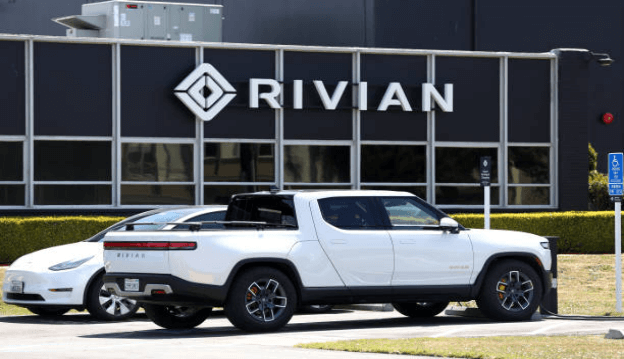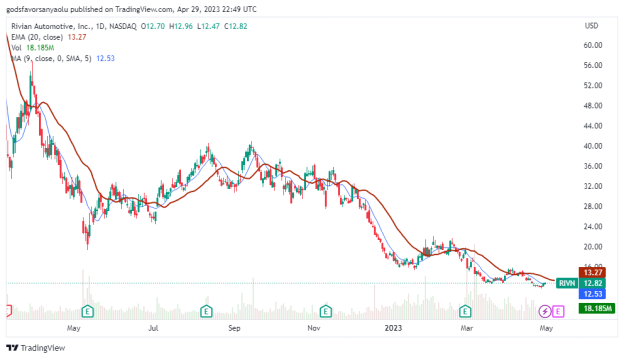With the rapid growth of the electric vehicle market, Rivian has gained significant attention as a promising player in the industry. As the company continues to gain ground and grow, many investors are wondering whether Rivian stock is a good investment opportunity. In this article, we will analyze Rivian's financials, market trends, and growth prospects to provide a comprehensive stock price forecast for 2023. We will also discuss whether now is the right time to buy or sell Rivian stock.
Introduction
Rivian is a U.S.-based electric vehicle (EV) manufacturer that was founded in 2009. The company has gained a lot of attention and investment over the years, with notable backers including Amazon and Ford.
Rivian stock (RIVN) went public on November 10, 2021, with an initial public offering (IPO) price of $78 per share. The stock (Nasdaq: RIVN), quickly surged on its first day of trading, reaching a high of $128.60 and giving the company a market value that is currently worth over 11 billion USD. Since then, RIVN stock has experienced significant volatility, with prices fluctuating between $11.68 - $40.86 per share.
Understanding the Rivian stock forecast is important if you are considering buying, holding, or selling the stock. A stock forecast can provide valuable insights into the company's financial health, growth prospects, and likely risks.
2022 Review of Rivian Stock
A. Financial Performance
Rivian Automotive, the electric vehicle (EV) startup, has been making headlines since its debut on the stock market in November 2021. The company's market capitalization has fluctuated significantly, but as of April 28, 2023, Rivian's market cap stands at approximately $11.89 billion, with a current stock price of around $12 per share.
RIVN Earnings
The stock had a challenging year in fiscal year 2022. In that year, the profitability margin ended at 0.00%, meaning the stock experienced a major downside. The income statement for the year showed total revenues of 1.66B and gross profit of -3.12B. The company spent 3.7B on expenses without making a profit, a very bad year for the EV carmaker. At the end of the year, the stock dropped at a whopping 80% rate.
As for debt and liquidity, Rivian has not yet issued any long-term debt, but it did raise $12 billion in financing before its IPO.
B. Industry Trends and Events

As the automotive industry undergoes a significant shift towards electric vehicles, Rivian is poised to benefit from this trend. The company is one of the leading manufacturers of electric adventure vehicles, which have been growing in popularity in recent years. These vehicles cater to consumers who are looking for environmentally-friendly and sustainable transportation options while still enjoying outdoor activities.
The EV market has been growing rapidly in recent years, and this trend is expected to continue. According to a report by Allied Market Research, the global electric vehicle market size was valued at $162.34 billion in 2019 and is projected to reach $802.81 billion by 2027, growing at a CAGR of 22.6% from 2020 to 2027. This presents a significant opportunity for Rivian, as it positions itself as a major player in the EV market.
Another industry trend that Rivian is tapping into is the rise of e-commerce and last-mile delivery. The company has partnered with major players such as Amazon and Ford to develop electric delivery vans, which are designed to meet the growing demand for e-commerce deliveries. This presents a significant opportunity for Rivian, as the last-mile delivery market is projected to grow at a CAGR of 18.3% from 2021 to 2028, according to a report by Grand View Research.
C. Market Response and Investor Sentiment
Since its IPO in November 2021, the market response to Rivian has been mixed. While the company's IPO was highly anticipated, the stock has been volatile, with periods of sharp declines and short-lived recoveries. Rivian's stock price reached an all-time high of $181.68 on December 1, 2021, just a few weeks after its IPO, but then began a steep decline, falling to a low of $25.05 on October 3, 2022. And the price of the stock fell lower to $12 per share at the end of Q1 2023.
While many investors are excited about the company's potential in the EV market and its high-profile backers, others are concerned about the company's ability to execute its business plan and reach profitability.
Rivian Stock Key Metrics to Watch
A. Financial Performance
As an investor, it's important to take a closer look at the company's financial performance to determine whether it's a wise investment choice.
Revenue Growth: Rivian experienced a significant increase in revenue in 2022, with a year-over-year growth rate of 2,914.55%. This growth rate is exceptionally high and can be attributed to the company's introduction of new products or expansion into new markets.
Operating Margin: Rivian's operating expense in 2022 was $3.73B, with a year-over-year change of -0.59%. While the company's revenue grew significantly, its operating expenses did not grow at the same rate, indicating improved operational efficiency.
Net Income: Rivian's net income in 2022 was -6.75B, with a year-over-year change of -44.03%. The negative net income is a concern for investors and stakeholders, and the company needs to implement measures to improve profitability.
Rivian Earnings per Share (EPS): The EPS of Rivian in 2022 was -6.34, with a year-over-year change of 57.10%. The negative EPS suggests that the company did not generate profits that could be allocated to shareholders. The year-over-year change indicates that the company's net income declined in 2022, which resulted in a decrease in EPS.
Rivian Price-to-Sales (P/S) Ratio: Rivian's P/S ratio in 2022 was 0.85, indicating that investors were willing to pay $0.85 for every $1 of Rivian's revenue.
B. Vehicle Deliveries

As of Q4 2022, Rivian has reported delivering 62,800 vehicles, including 47,500 R1T pickup trucks and 15,300 R1S SUVs. The company has a backlog of over 100,000 orders and is ramping up production to meet demand. The company is expected to ramp up deliveries in 2023 as it continues to expand production capacity.
C. Battery Technology Advancements
Rivian has made significant advancements in battery technology with its use of a custom-designed battery pack for its R1T and R1S vehicles. The company claims that its battery pack offers more than 400 miles of range and can be charged from 0-80% in just 50 minutes using a fast-charging network. Rivian is also working on developing solid-state battery technology, which it hopes will improve the performance and range of its vehicles even further.
D. International Expansion
Rivian has announced plans to expand into several international markets, including Europe, China, and Australia. In Europe, the company plans to begin deliveries in late 2023, starting with the UK, followed by other countries in the region. In China, Rivian has formed a joint venture with a local automaker to manufacture and sell vehicles in the country. The company has also announced plans to enter the Australian market, although no specific timeline has been provided yet. These expansions will significantly increase Rivian's global reach and help the company achieve its goal of becoming a leader in the electric vehicle market.
Risks and Challenges
A. Supply Chain Disruptions
Rivian relies on a complex global supply chain to manufacture its vehicles, which exposes the company to the risk of supply chain disruptions. These could include shortages of raw materials, production delays, or transportation disruptions.
B. Regulatory and Policy-based Risks
As an automotive company, Rivian is subject to a wide range of regulatory and policy-based risks. These risks include changes in fuel efficiency standards, emissions regulations, and safety requirements, among others.
C. Increasing Competition
The electric vehicle market is becoming increasingly competitive, with many established players like Tesla, GM, BYD, Ford and new entrants such as Li Auto Inc., Workhorse Group Inc., XPeng Inc., and NIO Inc., entering the market. This could lead to pricing pressures and reduced market share for Rivian. In addition, increased competition could also lead to increased marketing and research and development expenses in order to stay competitive, which could negatively impact the company.

2023 Expectations for Rivian Stock
A. Rivian's Financial Performance Forecast
Rivian's Chief Financial Officer has recently announced that the company is on track to become profitable by the second half of 2024. This is a positive development for the EV startup, which has been investing heavily in research and development and manufacturing facilities to ramp up its production volumes.
In its 10-K filing for fiscal year 2022, RIVN highlighted plans for a second manufacturing facility near Atlanta, Georgia, which will accommodate its next generation consumer vehicle platform, the R2. This facility is expected to be completed by 2026 and is crucial to achieving the company's long-term goals of mid-twenties gross margin and mid-teens EBITDA margins.
Based on this information, it is reasonable to say that Rivian's financial performance will most likely be positive for the next several years.
B. Market Share Projection
Based on Rivian's current plans and partnerships, the company is expected to grow its market share in the electric vehicle industry in the coming years. By 2025, Rivian plans to launch additional electric vehicles such as an electric SUV and a pickup truck, which are expected to contribute significantly to the company's sales growth. Based on these plans and projections, analysts expect Rivian to capture a significant share of the electric vehicle market, potentially reaching up to 5% by 2025.
C. Technical Analysis

Technical analysts use various tools and techniques to identify patterns, trends, and potential trading opportunities.
One commonly used tool is the moving average (MA) indicator, which is a trend-following indicator that smooths out price fluctuations and identifies the direction of the current trend. For example, if the current stock price is above the 200-day MA, it indicates a long-term bullish trend, and if the price is below the 200-day MA, it indicates a long-term bearish trend.
Another commonly used tool is the Relative Strength Index (RSI), which is a momentum oscillator that measures the speed and change of price movements. The RSI oscillates between 0 and 100, and readings above 70 indicate an overbought condition, while readings below 30 indicate an oversold condition.
Using these tools and others, technical analysts can generate buy and sell signals based on the stock's price movements. For example, a buy signal may be generated when the stock price crosses above its 50-day MA and the RSI indicates an oversold condition.
Here is a sample chart of Rivian stock with its 50-day and 200-day moving averages:

Based on this chart, we can see that Rivian's stock price has been trending below its 50-day MA for the past few months, indicating a short-term bullish trend. However, there have been lower highs and lows on the weekly timeframe, indicating a long-term bearish trend.
Technical Analysis of Rivian Stock: Identifying Trends, Candlestick Patterns, and Key Indicators for Trading Decision-making
There are various tools and techniques that can be used for technical analysis, but two important ones are trend analysis and candlestick pattern analysis.
Trend analysis for RIVN stock forecast: One key aspect of technical analysis is identifying the trend of a stock's price movement. A bullish trend is characterized by higher highs and higher lows, while a bearish trend is characterized by lower highs and lower lows. By analyzing the trend, traders can determine whether to buy or sell the stock. For example, if Rivian stock is in a bullish trend, it may be a good time to buy, while if it is in a bearish trend, it may be a good time to sell.
Candlestick pattern analysis: Another important tool for technical analysis is candlestick pattern analysis. This involves analyzing the patterns formed by the candlesticks on a chart to identify potential buy or sell signals. For example, a bullish engulfing pattern, where a small red candlestick is followed by a larger green candlestick, may indicate a potential buy signal, while a bearish engulfing pattern, where a small green candlestick is followed by a larger red candlestick, may indicate a potential sell signal.

Rivian Stock Forecast 2024
Targeting the fast-growing pickup and SUV segments, Rivian went public in late 2021 with a market cap that briefly topped $100 billion, but the stock has since fallen significantly to around $18. Rivian faces significant execution risk as it looks to ramp up production from about 20,000 vehicles in 2022 to an expected 200,000+ by 2025. If Rivian can achieve scale, develop a strong brand reputation around adventure and the outdoors, and maintain its lead in electric trucks/SUVs, the stock could recover to its post-IPO peak. However, losses will continue to mount over the next few years, requiring significant capital raises that could further dilute investors. Competition in the electric truck space is also heating up. While Rivian's long-term outlook remains promising assuming execution, the path to 2024 is rocky given macro uncertainty and the company's early-stage challenges. Conservative price targets for 2024 center around $25, but the stock will remain volatile with both significant upside and downside potential around production and demand trends.
Is Rivian A Good Stock To Buy?
It's possible to know if Rivian Stock is a good one to buy by looking into the following factors:
Innovative Technology: Rivian's impressive technology, sets it apart from other electric vehicle manufacturers like Tesla and NIO. For example, the Rivian R1S is capable of impressive power and torque that gives it an edge over the Tesla Model X.
Strong Brand: Rivian has established itself as a leading player in the electric vehicle market, with a brand that is synonymous with innovation, sustainability, and adventure. Its strong brand recognition can help attract customers and investors alike.
Manufacturing Capabilities: Rivian owns and operates its manufacturing facility in Normal, Illinois, which gives it greater control over the production process and the ability to scale up production as demand for its vehicles grows. Additionally, Rivian has invested heavily in advanced manufacturing technologies, such as 3D printing, to make its production process more efficient and cost-effective.
Service and Support: Rivian's commitment to service and support is another competitive advantage. The company realizes that customers will definitely need some help and has provided 24/7 service support centers. In 2021, Rivian reportedly invested $4.6M into this area.
What are the ways to trade Rivian stock?
There are three ways to trade Rivian stock: (1) hold its share; (2) options; and (3) contracts for difference (CFD).
Hold its share: This is the traditional way to invest in a company's stock. It involves buying shares of the company and holding onto them with the hope of making a profit over the long term through capital gains or dividends.
Options: Options trading involves the buying and selling of contracts that give the holder the right, but not the obligation, to buy or sell a stock at a predetermined price on or before a specific date. Options can be used to generate income, hedge against potential losses, or speculate on the future direction of a stock.
Contracts for Difference (CFD): CFD trading is a way of speculating on the price movements of a stock without actually owning the underlying asset. With CFD trading, traders enter into a contract with a broker to buy or sell an underlying asset at a specific price. CFD trading allows traders to use leverage, making it possible to amplify potential gains, but also increases the risk of losses.
CFD trading vs Traditional Stock Trading
CFD trading differs from traditional stock trading in several ways. CFD trading does not involve ownership of the underlying asset, whereas traditional stock trading involves purchasing ownership of the shares. CFD trading allows for short-selling, which is the ability to profit from a decline in the stock's price. Traditional stock trading, on the other hand, allows you to build a well-diversified portfolio with a long-term investment horizon. Also, CFDs are traded traded on margin, which comes with risk, whereas traditional stocks do not. Lastly, CFDs are highly speculative, whereas stock trading has a greater certainty of profit.
Why Trade Rivian Stock CFD with VSTAR?
Some reasons to trade Rivian stock CFD with VSTAR include:
Access to advanced trading platforms: No trader can trade the markets solely, therefore they rely on brokerage platforms. This is the same way VSTAR helps you get connected to top trading platforms.
Low trading fees: There are many brokers that have ridiculously high trading fees. However, VSTAR doesn't take advantage of traders as they charge relatively low trading fees.
24/7 customer support: Trading sometimes requires some help, either for questions or issues. This is why VSTAR has ensured that there is regular and active in-house support for traders who have urgent issues. Finally, VSTAR also offers a range of educational resources and tools to help traders make informed decisions.


Conclusion
Rivian is a company that has gained significant attention in the electric vehicle industry. Understanding Rivian's stock forecast is crucial for investors to make informed decisions about whether or not to invest. This article reviewed Rivian's financial performance, industry trends, and investor sentiment in 2022, as well as key metrics to watch such as financial performance, vehicle deliveries, battery technology advancements, and international expansion.
Finally, we discussed the three ways to trade Rivian stock, including holding its share, options, and CFD, and the benefits of trading with VSTAR. Ultimately, the decision to invest in Rivian stock depends on each individual's risk tolerance and investment strategy.
FAQs
1. Is RIVN a Buy, Sell, or Hold?
RIVN is currently rated "hold" by many analysts. The stock has potential but faces risks as a new automaker.
2. How high is Rivian stock expected to go?
RIVN's price targets range from $30 to over $100 over the next 12 months. Much depends on execution and macroeconomic conditions.
3. What will Rivian stock be worth in 2025?
For Rivian stock price prediction 2025, if Rivian executes well, RIVN could be worth $80-120 in 2025 based on projected growth and valuation. However, there are risks that it could be lower.
4. What is the prediction for RIVN stock in 2030?
For Rivian stock price prediction 2030, forecasts suggest that if successful, RIVN could reach about $200-300, boosted by EV adoption. But a lot can happen in 7 years.
5. What is the 5-year forecast for Rivian?
The 5-year outlook is cautiously optimistic. If Rivian can ramp up production, gain market share and turn a profit, RIVN could be a multi-bagger. But it's still early stage.


















